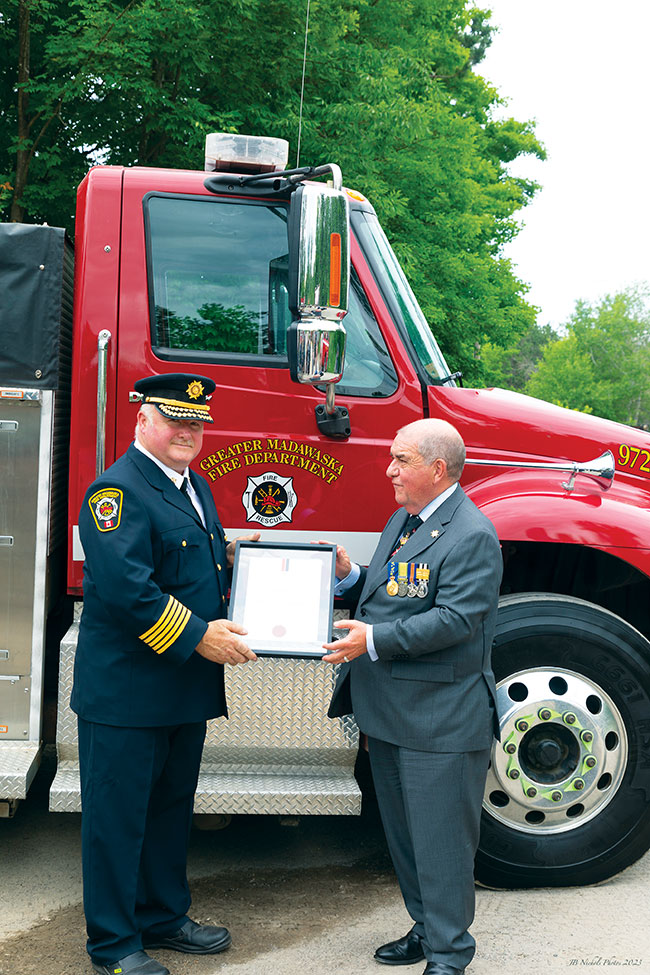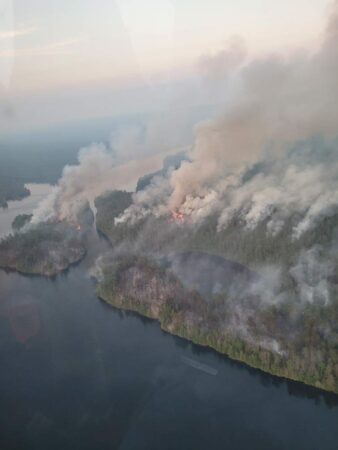
Wildfire crisis averted: How teamwork and dedication saved the day
By Brittani Schroeder
Features Canada wildfire season canadian firefighter editors pick firefighters Ontario wildfires Chief Pete Forshaw (left) and Lord Prior Mark Compton (right).
Photo: Pete Forshaw
Chief Pete Forshaw (left) and Lord Prior Mark Compton (right).
Photo: Pete Forshaw Pete Forshaw had only been Fire Chief of the Greater Madawaska Fire Department for three weeks when a wildfire started in his jurisdiction.
The fire began on a Sunday afternoon in early June on an island in Centennial Lake, which was right at the edge of the township’s border. The winds were blowing strong, and the fire made an incredible 160-foot jump across the water to the mainland.
Two fire stations were deployed—approximately 30 members—to the scene. “We quickly made an assessment to attack what we could because the fire was spreading at an unbelievable rate,” said Chief Forshaw. He contacted the Ministry of Natural Resources (MNR) and the wildland fire team at the Haliburton office, and a crew of eight people were sent to help.
Multiple teams were on the ground late into the evening Sunday, but unfortunately, they weren’t making much headway. “Trees that are 100 feet tall were on fire at the very top of the canopy. Our water can’t reach that high, so we had no way to suppress it. It was an unbelievable sight to see.” The trees were igniting off each other like a chain reaction, due to the dryness of the foliage at that time of year.
“I don’t know how people got my personal cell phone number, but I was getting calls left and right from people asking what they could do to help. I was getting calls until 3 a.m. I had people calling me from Oshawa, to Montreal, to people who were flying back to Ontario from Alberta after facing the wildfires there. It really showed that people truly are good at their core.”
Monday morning, 29 members from the township’s two fire halls were back at the scene by 6 a.m., joined by two crews from the MNR. Mutual aid partners were also brought in from surrounding townships, which meant that 53 people were on the doorstep of that fire. “We pulled over 4,000 feet of fire hose that day to attack the blaze.”
 The topography of the area didn’t help the firefighters in any way. “It’s relentless up here. It’s all rock, and very unstable to be walking through carrying 80-to-90-pound packs on your back. We needed to cycle out personnel periodically to rehydrate them and make sure they had what they needed before getting back in there.” The crews worked on the fire until 11 p.m., with a small victory at suppertime when the winds died down to 20 km/hr.
The topography of the area didn’t help the firefighters in any way. “It’s relentless up here. It’s all rock, and very unstable to be walking through carrying 80-to-90-pound packs on your back. We needed to cycle out personnel periodically to rehydrate them and make sure they had what they needed before getting back in there.” The crews worked on the fire until 11 p.m., with a small victory at suppertime when the winds died down to 20 km/hr.
On Monday, water bombers were able to attend the scene. “Because of the wildfires in Quebec, we couldn’t get any planes in their air out of Pembroke because of the thick smoke. We had to call on two Twin Otter Water Bombers, and a CL-415 from Sudbury. Those types of planes require a lot of fuel, and they are not great on mileage, so they were only able to stay for three hours and make 19 passes over the fire before turning around and heading back.”
With only having assistance from the water bombers for three hours, it was really up to the firefighters on the ground to circle the fire and push it back in on itself. Once this was accomplished, Chief Forshaw knew that it was finally starting to slow down. What was challenging, however, was the wind, which was still between 45 to 52 km/hr. It was blowing embers into unburned areas and creating numerous spot fires, so on Wednesday, Thursday and Friday, crew members were sent to put those out.
By Friday, strong headway was being made. A helicopter was also on-site dropping buckets of water on hotspots in a more precise manner than was possible with the planes.
“We needed to cycle out personnel periodically to rehydrate them and make sure they had what they needed before getting back in there.” – Chief Pete Forshaw

Photo: Pete Forshaw
By Saturday, they were working with a skeleton crew of less than 20 firefighters because people were starting to get worn out. The fire initially grew from one acre to 43.7 hectares, and it was finally stopped at the top of a large ridge. He believes that if they hadn’t stopped the fire on the ridge, they would’ve lost the battle.
The Greater Madawaska firefighters
All the firefighters in the Greater Madawaska Township are volunteer, save for one member. “Our firefighters took a week of vacation from their regular nine-to-five jobs to stop this blaze. It’s incredible.”
A captain at the Calabogie fire hall happened to be related to someone very high up in the St. John’s Ambulance organization, and they knew that Lord Prior of the Order of St. John, Mark Compton, was visiting the Ottawa area as this wildfire was taking place. He heard about the fire and decided that he’d like to meet the firefighters who fought back the blaze. “He and his wife are both firefighters back in Australia, and suddenly he wanted to come see us.” Chief Forshaw described Lord Prior Mark Compton as a sweet, down to earth man when he met him in person.
In the afternoon of June 23, Lord Prior Mark Compton visited the Calabogie Fire Station, along with the Calabogie captain’s uncle, and presented the gathered firefighters with St. John Ambulance Canada Life Saving Award pins. “He was such a nice gentleman, and he couldn’t thank the firefighters enough for what they did—and do—every day. He also presented the township with a Life Saving Award certificate for the fire department.”
During this interview, Chief Forshaw laughed when he recalled how he hadn’t even received his dress uniform yet, because he was still so new to the role of chief. “I hated to be that guy, but I had to call up the company and get them to rush my dress uniform so that I could look my best for Lord Prior Mark Compton. I received it the night before he visited us, and what an honour it was to meet him.”
Chief Forshaw says that he smiles when looking back at the event, because his team was able to put that fire out so quickly, even with the hurdles they faced. “If we had those planes from Pembroke putting water on the fire the same day it started, then the fire would’ve been under control in two days. But because we were handcuffed by the smoke, we put boots on the ground and put a stop to it ourselves.”
Print this page
Advertisement
- Borrowing for three new fire trucks goes to referendum
- Pitt Meadows names Stephan Drolet as new Fire Chief